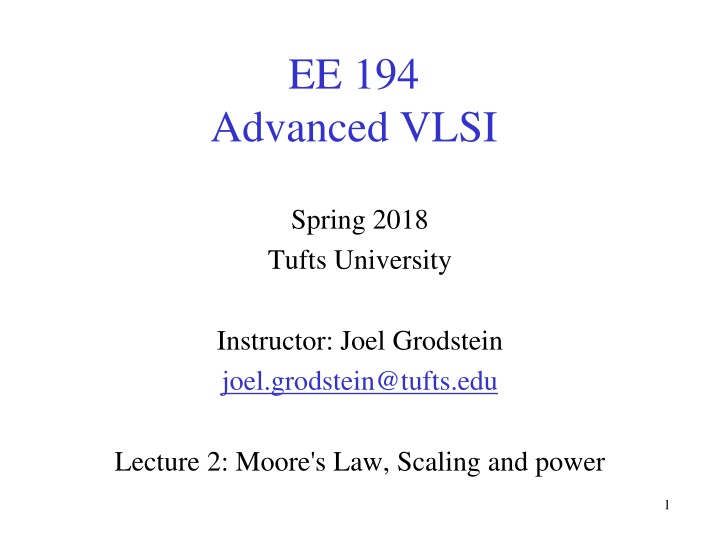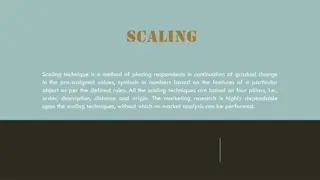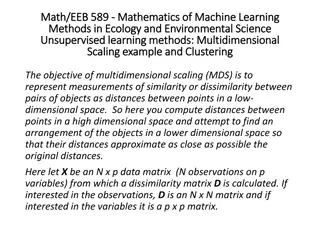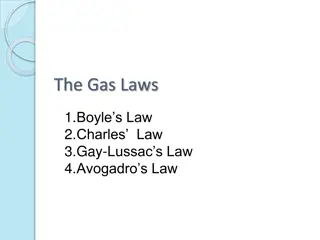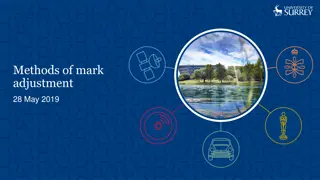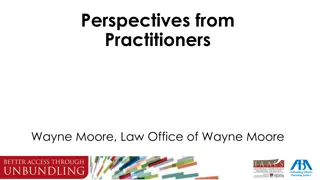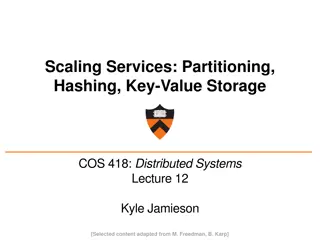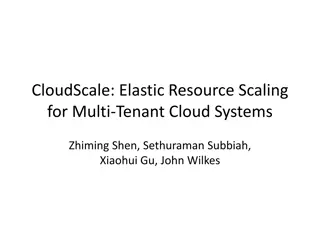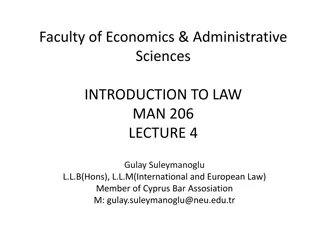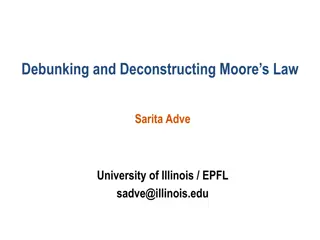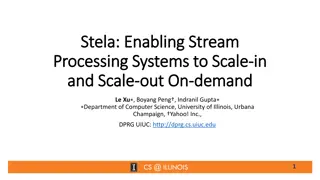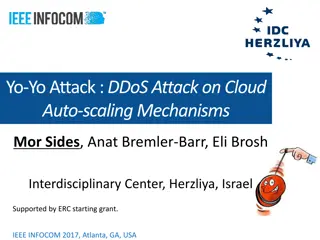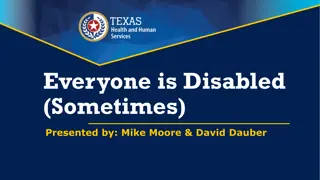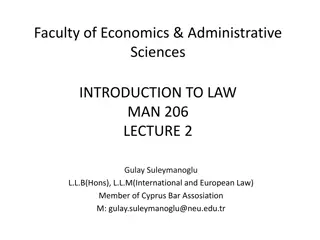Moore's Law and Technology Scaling
Delve into the implications of Moore's Law and technology scaling in VLSI design. Explore the impact of wire capacitance and resistance on performance and efficiency. Uncover the challenges faced in achieving continued advancements in semiconductor technology.
Download Presentation

Please find below an Image/Link to download the presentation.
The content on the website is provided AS IS for your information and personal use only. It may not be sold, licensed, or shared on other websites without obtaining consent from the author.If you encounter any issues during the download, it is possible that the publisher has removed the file from their server.
You are allowed to download the files provided on this website for personal or commercial use, subject to the condition that they are used lawfully. All files are the property of their respective owners.
The content on the website is provided AS IS for your information and personal use only. It may not be sold, licensed, or shared on other websites without obtaining consent from the author.
E N D
Presentation Transcript
EE 194 Advanced VLSI Spring 2018 Tufts University Instructor: Joel Grodstein joel.grodstein@tufts.edu Lecture 2: Moore's Law, Scaling and power 1
Technology scaling Everyone has heard of Moore s Law. It s probably been mentioned in most newspapers at some point. But what does it really mean? Every generation (1-2 years) all dimensions scale by 0.7 72=0.5, so devices/unit area doubles Consequences: 1000x performance increase from 1990-2010 Changed our lives Why is Moore s Law true? It's less of a natural law, and more of a prediction of human progress. Actually making this happen has had huge consequences The definition of a "generation" is getting longer! Let's examine the consequences of scaling dimensions EE194/Adv VLSI Joel Grodstein 2
What do wires look like Chips have multiple layers of metal Typically, each successive layer runs perpendicular to the layers above, below That was beyond my artistic skills W H L Clat Carea EE194/Adv VLSI Joel Grodstein 3
Wire capacitance Does anyone remember the formula for capacitance? Carea LW/Hinter-layer Ignores fringing cap, etc. Cnew= (Lnew)(Wnew)/(Hinter-layer,new)= (.7L)(.7W)/(.7Hinter-layer) = .7C Intuitive explanation of what capacitance is? W H a capacitor doesn t like you to change the voltage across it. A big cap means that it takes a lot of charge flowing in to raise the voltage L Clat Hinterlayer Carea EE194/Adv VLSI Joel Grodstein 4
What was supposed to happen The master plan Capacitances keep getting smaller. A scaled transistor still effectively drove as hard So delays keep getting faster. The plan worked fine from about 1985-2005 The golden age of computing: everything kept getter better and better all the time And then it didn t wire R, physics and money got in the way we ve still not quite figured out what to do about it EE194/Adv VLSI Joel Grodstein 5
Wire resistance Does anyone remember the formula for resistance? R = L/(WH), where =1.7x10-8 m for copper Ignores inductive effects (return resistance, skin effect), Rnew = Lnew/(WnewHnew)= (.7L)/((.7W)(.7H)) = R/.7 So if a wire just shrinks evenly, its resistance gets higher each generation! Very bad. W H L Clat Carea EE194/Adv VLSI Joel Grodstein 6
Wire resistance Physical analogy: a pipe of water. It s hard to get water through a skinny pipe. even if it s short W H L Clat Carea EE194/Adv VLSI Joel Grodstein 7
RC scaling Wire delay RC (roughly) (RC)new=RnewCnew = (?R)(?C) So wire RC delay is constant (assuming we ve shrunk all dimensions equally) Rtotal=Rdevice+Rwire Wire delay didn t shrink, and that eventually slowed delay scaling How does the value of Vdd affect the RC delay? RC delay is independent of voltage: raising or lowering supply voltage makes no difference =(R/.7)(.7C)=RC V t EE194/Adv VLSI Joel Grodstein 8
RC scaling What about the time to cross a fixed distance (e.g., to cross the die with one long wire) R = L/(WH) Capacitance LW/Hinter-layer Now L remains constant, rather than shrinking (W, H shrink) Compute it yourselves: Rnew = Lnew/(WnewHnew)= (L)/((.7W)(.7H)) = R/.72 Cnew= (Lnew)(Wnew)/(Hinter-layer,new)= (L)(.7W)/(.7Hinter-layer) = C (RC)new = RnewCnew = (R/.72)(C) = 2RC The RC delay to cross a fixed distance doubles each generation. Sounds bad? In practice, nobody does this (see our HW1). EE194/Adv VLSI Joel Grodstein 9
Transistor scaling This is not a course in device physics; we will (must) gloss over almost everything . Suffice it to say that: Scaling transistors is very hard. The physics is becoming black magic (and very expensive). Intel Fab 42 (7nm) = $5B equipment cost. 1.2nm gate-oxide thickness is only about 5 atoms thick, resulting in gate leakage. Device threshold voltages must get smaller to scale speed, but this results in more sub-threshold leakage (kT/q is constant). Transistors somehow continue to shrink. Device currents do continue to increase, which (along with less capacitance) keeps delays decreasing but not much EE194/Adv VLSI Joel Grodstein 10
Power Now for the fun part. What are the units of power and energy (from 1st-semester physics)? Energy is an amount of work (Joules) Power is energy per unit time (a derivative, J/sec or Watts) Why we care A battery holds a fixed amount of energy. After we expend that much energy, it s dead. If a chip uses 5W of power, then how much heat does it generate? 5W. A chip does no mechanical work, so all power is converted to heat. High power means your chip can double as a toaster . EE194/Adv VLSI Joel Grodstein 11
A Microprocessor as a HotPlate = ? EE194/Adv VLSI Joel Grodstein 12
Circuit-level power, take 1 VOUT VIN C What is this circuit? Simple CMOS inverter You all remember this from EE103, right? When the input falls, the output ??? rises EE194/Adv VLSI Joel Grodstein 13
Circuit-level power, take 1 VOUT VIN C When the output rises, energy is expended. Where does it go? Energy stored in the electric field of a capacitor = .5CV2 Energy dissipated as heat via resistance = .5CV2 (extra-credit problem derives this) If there were no resistance, how much heat would be created? None! Ideal capacitors do not generate heat EE194/Adv VLSI Joel Grodstein 14
Dynamic power A capacitor stores and releases electric charge. This creates an electric field, which stores energy. A capacitor does not create heat. But the charge on a capacitor gets there through wires and transistors, which have resistance. Any time charge flows through resistance, that process creates heat. Intuitively, think of any mechanical object that moves against friction. It gets hot. The more friction and the faster the movement, the hotter it gets. The power supply charges & discharges capacitance through transistors and wires, which burn power & emit heat. EE194/Adv VLSI Joel Grodstein 15
Dynamic power Then energy stored in the capacitor is .5CV2. Miraculously, this is also the heat generated by the resistance. The actual resistance of the transistors and wires is irrelevant! Not always a general law, but works pretty well for our case. See the extra-credit problem for more detail. If energy to switch one node is .5CV2, then power=?????? ????? ????? ?? ??? Which energy are people talking about when they say .5CV2f? The energy dissipated as heat through the resistor The capacitive energy will get turned into heat when we discharge =.5CV2f EE194/Adv VLSI Joel Grodstein 16
Worst-case power scaling From about 1980-2005, performance kept increasing people kept V fairly high, since higher V higher freq frequency scaled superlinearly Assumptions for capacitance: If die area stayed the same Ctotal gets linearly bigger each generation (Wtotal, Ltotal remain constant, H shrinks) In fact, die area keeps increasing (more xtor more performance) Plus, leakage kept getting worse fell slowly not looking good! CV2f much bigger EE194/Adv VLSI Joel Grodstein 17
The Power Problem In about 2005, the industry started getting very serious about power. How did they do it? Necessity was the mother of invention. EE194/Adv VLSI Joel Grodstein 18
Why power stopped increasing Because frequency stopped increasing! They avoided having chips double as nuclear reactors by no longer increasing frequency (and other tricks, too) EE194/Adv VLSI Joel Grodstein 19
Power scaling since 2005 Frequency has not gotten much higher Future topic: DFVS, adapting freq to demand Voltage scaled down as fast as it could But kT/q is a fundamental limit Die areas have gotten larger over time, .5CV2f hasn t. Reasons why (architectural or circuits)? As noted, f has stayed pretty constant Extra die area has been use for low-power caches, with little switching Or for integrating system logic, with low f. Dark silicon is the logical extension of this GPUs are an exception Coming soon: clock gating keeps Ceffective << Ctotal EE194/Adv VLSI Joel Grodstein 20
Cooling an iPod nano ... iPod relies on passive transfer of heat from case to the air. Why? Users don t want fans in their pocket ... To stay cool to the touch via passive cooling, power budget of 5 W. If iPod nano used 5W all the time, its battery would last 15 minutes EE194/Adv VLSI Joel Grodstein 21
Battery: Set by size and weight limits ... Battery rating: 55 W-hour. At 2.3 GHz, Intel Core Duo CPU consumes 31 W running a heavy load - under 2 hours battery life! And, just for CPU! 46x more energy than iPod nano battery. And iPod lets you listen to music for 14 hours! Almost full 1 inch depth. Width and height set by available space, weight. At 1 GHz, CPU consumes 13 Watts. Energy saver option uses this mode ... EE194/Adv VLSI Joel Grodstein 22
Servers: Total Cost of Ownership (TCO) Machine rooms are expensive. Removing heat dictates how many servers to put in a machine room. Electric bill adds up! Powering the servers + powering the air conditioners is a big part of TCO. Should we care about power for big Reliability: running computers hot makes them fail more often. servers? 23 EE194/Adv VLSI Joel Grodstein
Facebook server farm: Sweden a EE 194/Adv. VLSI Joel Grodstein 24
Advertising campaign for Utah EE 194/Adv. VLSI Joel Grodstein 25
Power is a problem Scaling is making power a bigger and bigger problem Let s look at it in more detail and look at how to minimize it. EE 194/Adv. VLSI Joel Grodstein 26
Static Power Dissipation Vin ISC C Short-Circuit Current: Direct Current Path between VDD and GND when both NMOS and PMOS transistors are conducting caused by finite-slope input signals and by subthreshold leakage anyone remember what that means? EE194/Adv VLSI Joel Grodstein 27
Static Power Dissipation Vin ISC C Assume Vdd=1V, Vt=.4V If .4V<Vin<.6V, then both N and P devices will be on Lower Vdd to .7V What voltage range will incur ISC? Subthreshold leakage means that both devices conduct somewhat for (e.g., for the N) Vin<VTn. Lowering Vdd definitely reduces ISC. Vin >.4 and <.3 So, does not occur. But EE194/Adv VLSI Joel Grodstein 28
Effect of slew rate on ISC Vin ISC V C t Vin can be either the solid black (fast slew rate) or dotted black (slow) line; Vout is blue. Which Vin will lose more energy from ISC? slower slew rate will spend more time in the ISC region same currents, but over more time more energy EE 194/Adv. VLSI Joel Grodstein 29
Range of reasonable gate sizes Assume that the right-side inv has a fixed size What are the pros and cons (speed and power) of having the left-side inv be much smaller, about the same, or much larger? Bigger means faster. But there are diminishing returns. And bigger area means more capacitance and more power Smaller means less power. But it also means slower. And slower means more ISC through the right-side inverter EE 194/Adv. VLSI Joel Grodstein 30
How far can you lower Vdd? Lowering Vdd will lower CV2 quadratically, and also lower ISC. How low can you go? As Vdd approaches VT, gate delay gets much larger (not just linearly) What if Vdd gets even lower than VT? Can any devices turn on? Nominally not, but subthreshold conduction still works Inverters can still function Very low power, but extremely slow Can we lower VT? Not really; we become susceptible to exterior fixed-magnitude noise kT/q is constant, and we get hit by random thermal noise EE 194/Adv. VLSI Joel Grodstein 31
Static Power Dissipation Vin C Gate leakage Gate leakage is a quantum tunneling phenomenon The gate oxide is an insulator; classical physics says no current can flow through it When gate-oxide thickness is small enough, quantum tunneling can occur electron s momentum & position cannot both be known precisely; if you know it is not moving fast enough to surmount the energy barrier, then you don t know which side of the oxide it s on EE194/Adv VLSI Joel Grodstein 32
In-class group exercise Why would each of these tricks reduce static power? Use fewer & smaller-width transistors Less transistors leaking; and I=V/R, so more R means less Isc each Lower supply voltage reduces subthreshold leakage and thus ISC Keep signal slew rates fast Less time when both transistors are on, so reduces Isc duration Increase VT reduces subthreshold leakage (but hurts speed) Why might physical designers use high-VT devices, but then change to low-VT on critical paths? To expend leakage power only where it will do the most good Switch to high-k dielectric reduces gate leakage (but increases gate capacitance) EE194/Adv VLSI Joel Grodstein 33
Reducing dynamic power Next up: how can we reduce dynamic power? EE 194/Adv. VLSI Joel Grodstein 34
Activity factor We said that: energy to switch one node is .5CV2 power=?????? this assumed that switches/sec=f; i.e., every node switches once every cycle ????? ????? ?? =.5CV2f ??? In more detail: power=?????? ????? ????? ?? ?????? ??? = (.5CV2) AF f ????? AF is the activity factor potentially different for every node says (on average) how many switches to expect per cycle Ceff AF C combines AF and C into one number: so power= .5CeffV2f EE194/Adv VLSI Joel Grodstein 35
Activity-factor examples Consider a counter that increments every cycle What is the activity factor for Its low-order bit (bit #0)? Bit #1? The clock? Vdd? If bits #0 and #1 have C=20ff, Cclock=500ff and Vdd has C=10000ff, which has the most dynamic power? The clock overwhelms any other single node (and is often comparable to all other nodes combined) 1 .5 2 0 EE194/Adv VLSI Joel Grodstein 36
Lowering Dynamic Power Reducing Vdd has a quadratic effect Also increases gate delay ~linearly (until Vdd VT) If we lower voltage and freq, power reduces cubically. Keep It Simple, Stupid architectural complexity size long wires, big capacitances power. Reduce switching activity Clock Gating idle units or stalled pipe stages Reduces AF and thus Ceffective. EE194/Adv VLSI Joel Grodstein 37
Clock gating Perhaps the most common technique for reducing power. It is powerful. Consider the cone of logic driving a node (i.e., the transitive fanin all the way back to registers). If all of the registers are clocked by the same clock, and it s gated, then the entire cone is quiescent. Turn off as many clocks as you can! Leave on the ones that are doing real work Examples to draw: E-stage adder and multiplier: clock them together? Two bits of the same datapath: clock them together? EE194/Adv VLSI Joel Grodstein 38
Limits to clock gating Flops that are changing must clock Physical-design limits on granularity It s physically painful to make many low-fanout clocks. So we usually have a reasonably small number of fairly high- fanout clocks We can only gate off the clock when everything it drives is guaranteed to be inactive. Turning off an entire pipe stage, or an entire unit, is a Really Good Thing EE 194/Adv. VLSI Joel Grodstein 39
Di/dt noise Circuits 101: V = L di/dt L = inductance (dominated by how big your package is) di/dt = how fast total supply current changes When current changes rapidly, you get voltage spikes Any physical intuition for why that is? An inductor will not let the current through it change instantly. When you try to do so, it induces a voltage to create a counteracting current. voltage current time EE194/Adv VLSI Joel Grodstein 40
Di/dt noise Circuits 101: V = L di/dt So if we are doing lots of computation, and we suddenly run out of data and stop, then our voltage rises (and, e.g., perhaps puncture gate oxide) And if we are waiting for data and so not doing much, and the data arrives and we quickly do computation, then our voltage drops (and, e.g., latches lose state). But didn t we just say to turn off clocks aggressively? Yes, but not too aggressively And don t turn them all on at once! Big servers often have micro-architectural hooks to control this Consequences: Limits how aggressively we can turn off circuits to conserve power It s one limit on how low we can make Vdd (i.e., we have to be sure the supply voltage stays a lot bigger than the di/dt noise!). EE194/Adv VLSI Joel Grodstein 41
Summary of reducing power We went over many ways to reduce power: Keep supply voltage as low as feasible (within performance limits) Keep Vt high (except for critical paths) Keep frequency as low as possible Keep gate delays reasonable Sleep units whenever possible Turn off clocks to reduce dynamic power (but watch out for di/dt) Remember: architectural complexity size long wires, big capacitances power (Keep It Simple, Stupid) EE194/Adv VLSI Joel Grodstein 42
The future Everyone has predicted the end of Moore s Law for 15 years already. It hasn t stopped yet, but it definitely has slowed down. Manufacturing costs have risen. Any Law predicting exponential growth clearly cannot keep going forever! And Moore s Law violates Murphy s Law . Living with the end of Moore s Law (power) will be a recurring theme for the rest of the course EE194/Adv VLSI Joel Grodstein 43
Coming up later EE194/Advanced Architecture focuses on architectural power savings. Our next topic will be static-timing analysis and speed binning lots of connections with minimizing power and setting Vdd Then comes clocking we ll cover conditional clocks in a lot of detail Another unit on DFVS all about saving power by lowering V and F We may also discuss dark silicon We may discuss timed digital logic Perhaps the most power-efficient form of digital logic EE194/Adv VLSI Joel Grodstein 44
In-class exercises If we double the thickness of the oxide between metal layers, how does that affect R and C of wires? Can you think of any disadvantage to doing this? A particular circuit has a total of 10 pF of capacitance, and runs at 2 GHz at .9V with an activity factor of .2. Compute Pdyn. If the static power is 1mW, compute the total power. If the computation requires 2000 cycles, how much heat will be generated? EE 194/Adv. VLSI Joel Grodstein 45
